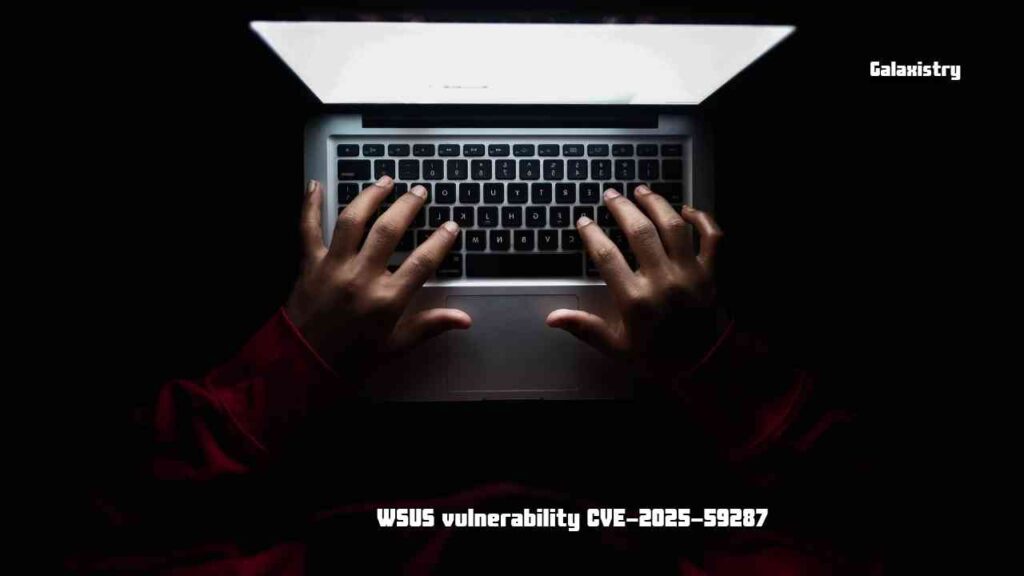CISA WSUS Vulnerability CVE-2025-59287: Hello system administrators and cybersecurity professionals! If your job involves managing Windows servers, the next few minutes are going to be very important for you. In the world of cybersecurity some vulnerabilities are merely “dangerous,” while others can be a “death warrant” for your entire network and CVE-2025-59287 falls into the “death warrant” category. This is a Remote Code Execution (RCE) flaw found in Microsoft Windows Server Update Services (WSUS) that has received a CVSS rating of 9.8 (Critical). It’s an almost perfect “total compromise” score.

And now, CISA (Cybersecurity and Infrastructure Security Agency) has issued a HIGH-PRIORITY advisory on this. The advisory doesn’t just say there’s a threat; it says hackers are actively exploiting it and CISA has released new threat-hunting methods to catch the attackers. This article’s in-depth analysis will tell you why the CISA WSUS vulnerability CVE-2025-59287 exploit guide is important, how hackers are exploiting it and how you can immediately protect your servers by following CISA’s new directives.
What is WSUS and why is this flaw so destructive?
WSUS (Windows Server Update Services) is Microsoft’s trusted server used by almost every large organization to distribute security patches and updates to their Windows computers.
It’s essentially your network’s “immune system.” When WSUS is instructed to download and install an update on all client machines (like employees’ laptops), it operates with SYSTEM privileges — meaning the highest level of authority on the computer.
What is the CVE-2025-59287 vulnerability?
This vulnerability allows an unauthenticated attacker to run arbitrary code (such as malware or ransomware) on the WSUS server with SYSTEM privileges.

In plain words:
- ‘Unauthenticated’: the attacker does not need to know your WSUS server’s password.
- ‘Remote Code Execution’: they can attack your server from anywhere on the internet.
- ‘SYSTEM Privileges’: once inside, they become the ‘God’ of your server.
For attackers compromising a WSUS server feels like hitting the jackpot. Why? Because a WSUS server is by default ‘trusted’ by every other computer on the network.
If an attacker takes control of your WSUS, they can push ransomware as a ‘fake Microsoft update’ to every computer on your network at once and no antivirus will stop it (because it’s coming from a ‘trusted’ WSUS).
What does CISA’s new alert say?
Microsoft released a patch for this vulnerability on Patch Tuesday. But that patch was incomplete. Attackers reverse-engineered that incomplete patch and developed a new exploit. Microsoft had to reissue an out-of-band (emergency) patch. Taking advantage of that chaos, attackers struck.
CISA has added CVE-2025-59287 to its Known Exploited Vulnerabilities (KEV) catalog. That means the U.S. government has officially confirmed this is not just theory—attackers are actively using it to hack organizations.
CISA’s new advisory is not just telling sysadmins to “patch.” It’s saying: “Assume your server is already compromised and start hunting for the attackers.”
How to catch the hackers: CISA’s new threat-hunting guide
This is the most important part of the CISA WSUS vulnerability CVE-2025-59287 exploit guide. CISA has provided information about the “digital fingerprints” left by the attackers. Hackers are using PowerShell on WSUS servers while running as SYSTEM. You must immediately check these two things in your WSUS server logs:
1. Suspicious Child Processes:
- Generally, the WSUS service (wsusservice.exe or w3wp.exe) has no reason to run PowerShell or cmd.exe (Command Prompt).
- Check your Endpoint Detection and Response (EDR) or SIEM logs: did the wsusservice.exe process launch powershell.exe as a child process?
- If yes; this is 99.9% a sign of compromise.
2. Base64 Encoded Commands:
- Attackers encode their malicious code (malware) in Base64 to hide it so it looks like gibberish in the logs.
- CISA warns to look for PowerShell instances running with arguments like -e, -en, -enc or -encodedcommand.
- This is a classic living-off-the-land (LotL) technique where the attacker uses your own tools against you.
Your Immediate Action Plan (Immediate Action Plan)

If you run WSUS, this is non-negotiable. Do this now:
1. Patch Immediately:
This is the first step in the CISA WSUS vulnerability CVE-2025-59287 exploit guide.
Make sure you have installed the out-of-band (emergency) patch released by Microsoft on October 23, not just the older Patch Tuesday update from the month.
2. Start Hunting:
Don’t just sit back after patching. Follow CISA’s guidance.
Check the process execution logs and PowerShell logs on your WSUS server (and Domain Controllers). Look for the child processes or encoded commands mentioned above.
3. Harden WSUS:
Do not expose your WSUS server directly to the internet. Keep it behind a firewall.
Configure WSUS to use HTTPS/SSL so that the traffic between the client and server remains encrypted. While this won’t stop this specific exploit, it will help prevent future man-in-the-middle attacks.
Conclusion: CISA WSUS vulnerability CVE-2025-59287
CVE-2025-59287 is a perfect storm: it targets the most trusted part of your network (WSUS), requires no password (unauthenticated) and grants the highest privileges (SYSTEM).
CISA adding it to the KEV catalog and releasing a dedicated threat-hunting guide confirms that the threat is real and happening right now. Patch your servers but more importantly, check your logs. The hacker might already be inside your network.